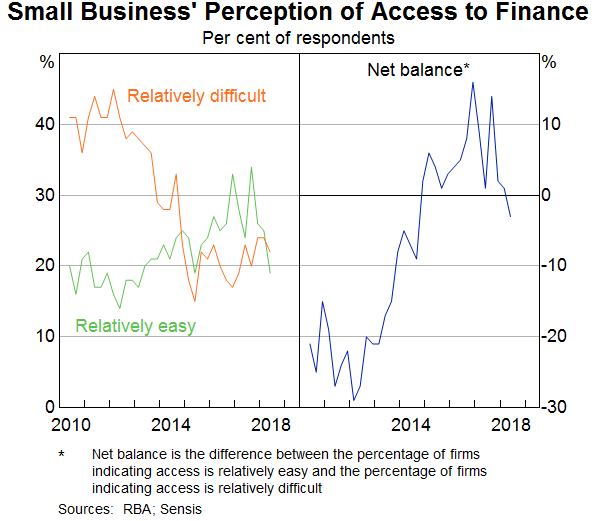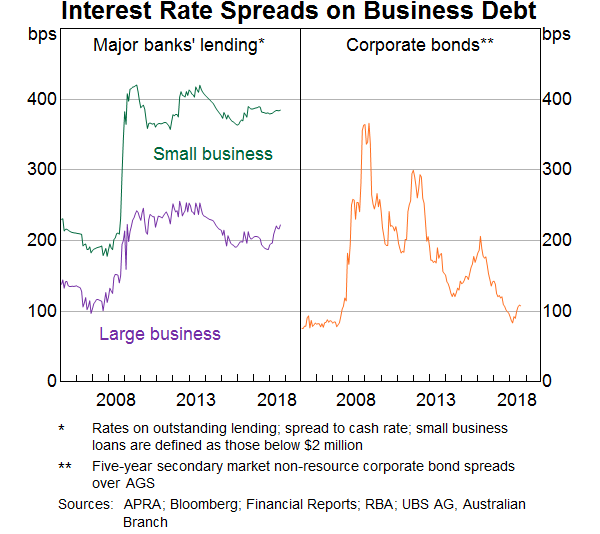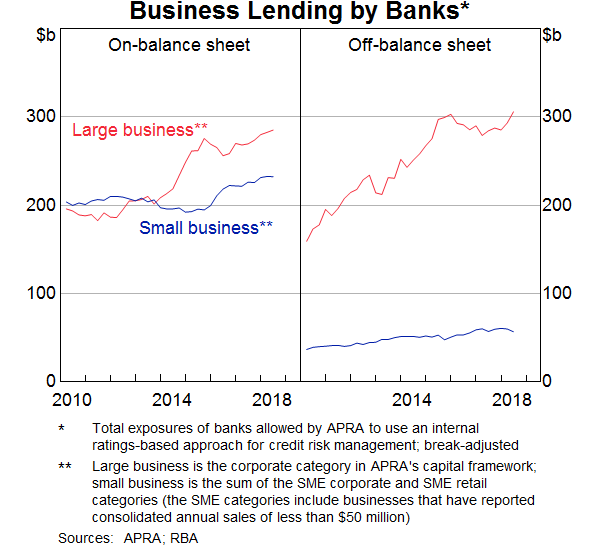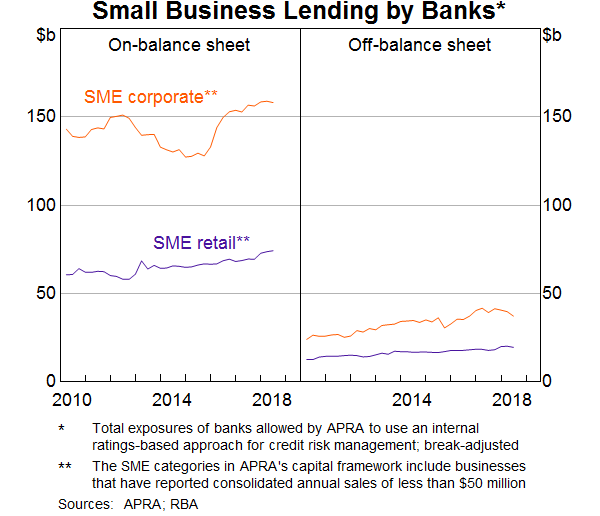Bulletin – September 2018 Australian Economy Access to Small Business Finance
- Download 371KB

Abstract
The Reserve Bank has conducted additional outreach this year to hear a broad range of perspectives on small business finance. Many small businesses looking to grow still find it challenging to access finance, particularly without providing real estate as security. Lenders highlight that they are keen to lend to small businesses, but that unsecured finance involves more risk. This article considers these issues and outlines some initiatives market participants have suggested that could help to improve access to finance for small businesses.
Each year, the Reserve Bank convenes its Small Business Finance Advisory Panel to better understand the challenges faced by small businesses.[1] This year, the Reserve Bank has also hosted two special roundtable events. The first was co-hosted with the Australian Banking Association (ABA) and the Council of Small Business Australia. Participants discussed the challenges faced by small businesses when borrowing from banks. The second was co-hosted with the Australian Treasury and the Australian Finance Industry Association (AFIA). This roundtable focused on innovative financing options that are emerging from outside the traditional banking system.[2] This article summarises the issues that have been highlighted by entrepreneurs, lenders and equity investors regarding access to small business finance.
The Entrepreneurs' Perspective
The message from the Small Business Finance Advisory Panel and surveys continues to be that many small businesses find it challenging to access finance. While conditions are better than they were in the period just after the global financial crisis, around one-fifth of businesses report that they have found it relatively difficult to access finance (Graph 1). In addition, the proportion of small businesses that perceive it to be relatively easy to access finance has declined recently.

While interest rates on business loans are near historic lows, there continue to be differences between the rates paid by small and large businesses. The spread of interest rates on small business loans relative to the cash rate has remained persistently high since the global financial crisis (Graph 2). In contrast, interest rate spreads on corporate bonds issued by large businesses have declined since earlier this decade. Research recently published by the Reserve Bank has found that smaller and riskier companies faced high borrowing rates, which was constraining their investment (Hambur and La Cava 2018).

The entrepreneurs on the Reserve Bank's Advisory Panel have highlighted the following key issues:
- Access to finance for start-ups is very limited: banks are reluctant to finance start-ups given the high risks involved. Entrepreneurs often resort to using personal credit products (such as credit cards) to fund their day-to-day operations when they start their business. Equity financing would often be more appropriate, particularly for start-ups, but there are relatively few avenues for such financing in Australia.
- Banks are reluctant to extend finance without real estate as collateral: entrepreneurs looking to expand their business are concerned by the collateral and personal guarantees they need to provide to obtain sufficient finance.[3] They find it difficult to borrow more than around $100,000 on an unsecured basis to support their day-to-day trading activities. In addition, medium-sized businesses report that it is hard to obtain additional finance once they have pledged all of their real estate as collateral. As a result, many entrepreneurs delay expansion until it can be funded from retained profits.
- The process to obtain finance is lengthy and onerous: entrepreneurs report that banks are reluctant to provide them with advice on how to obtain finance. As a result, they find it difficult to compare lending products and determine the one that would suit them best. When they apply, they have to provide a large amount of information and documentation. The banks then take a long time to decide whether to extend the loan. This can be particularly problematic if the business opportunity is time sensitive. While innovative non-bank lenders are offering products with streamlined application processes, the annualised interest rates on these products are often very high.
- Large businesses continue to impose onerous payment terms: some large businesses require small business suppliers to accept payment times well beyond 30 days. The Australian Small Business and Family Enterprise Ombudsman (ASBFEO) drew attention to this issue in a report last year (ASBFEO 2017). In response, the Business Council of Australia published the Australian Supplier Payment Code, which commits signatories to pay small businesses on time and within 30 days. However, some large businesses have not signed the code and their payments are frequently delayed well beyond this benchmark.
The Lenders' Perspective
In response to the concerns raised by entrepreneurs, banks highlighted at one of the roundtables that their lending to small businesses has been growing over recent years (Graph 3). However, it has tended to grow more slowly than their lending to large businesses. Also, banks' off-balance sheet exposures to small businesses are well below those to large businesses; this may reflect reluctance by banks to extend undrawn facilities, such as overdrafts and bank guarantees, to small businesses. Within lending to small and medium-sized enterprises (SMEs), the growth has been spread across both smaller businesses (the ‘SME retail’ exposures of the banks, which are below $1 million) and medium-sized businesses (the ‘SME corporate’ exposures, which are typically above $1 million) (Graph 4).


On a portfolio basis, lending to small businesses can be quite profitable for the banks, and the risk is mitigated by property collateral. Banks emphasise that the challenges small businesses face in accessing unsecured finance mainly reflect the higher risk associated with this form of lending. Market participants and the Productivity Commission have raised some concerns about the effect of prudential capital requirements on lending to small businesses (Productivity Commission 2018). In particular, they argue that the capital requirements encourage banks to seek residential property as collateral for these loans. The Australian Prudential Regulation Authority (APRA) released a consultation paper earlier in the year, which included some proposed changes to the treatment of small business lending (APRA 2018).[4]
The increased scrutiny of conduct in the financial services sector has extended to lending to small businesses. Market participants have highlighted that there is a trade-off between providing more protections for small business borrowers and the willingness of banks to lend. There is often a blurred line between the business and personal finances of entrepreneurs, so banks can find it operationally easier to also apply the responsible lending rules for consumers to small businesses. This could be contributing to the issues that entrepreneurs have raised about the loan application process.
In response to the increased scrutiny, the industry associations have been updating their standards for small business lending. The ABA's new Banking Code of Practice was recently approved by the Australian Securities and Investments Commission (ASIC) and will provide additional protections for small businesses. It includes limits on the use of ‘non-monetary default’ clauses in loan contracts (these clauses allow banks to put customers who were still meeting their loan repayments into default for breaching a loan condition). The new code will also require banks to provide three months' notice if they are not intending to extend a loan facility. In addition, AFIA recently released a Code of Lending Practice for online small business lenders. The Code aims to improve the transparency of the products offered by these lenders, particularly regarding the cost of finance for the borrower.
The Reserve Bank also engaged with a range of innovative non-bank lenders to small businesses that have entered the market to compete with the banks. These include new online lenders and marketplace platforms. These lenders are generally providing short-term unsecured cash flow finance of up to $250,000, with a streamlined loan application and decision-making process. While these lenders are growing rapidly, overall they remain a very small share of small business finance. A key issue faced by these lenders is their high cost of funding relative to the banks. This is related to the fact that unsecured small business lending is relatively high risk, and is one reason why these lenders often charge very high interest rates.
The Equity Investors' Perspective
The Reserve Bank also engaged with venture capital funds and family offices to better understand their role in financing small businesses. These funds tend to specialise in particular industries and target a few businesses with high growth potential. These investment opportunities are typically identified through market research or via networks. There has been a significant increase in fund raising for venture capital in recent years, sourced mainly from superannuation funds and government initiatives (such as the $500 million Biomedical Translation Fund). This has been supported by the introduction in July 2016 of tax incentives for investments in early stage innovative companies. Nevertheless, the supply of venture capital remains small in Australia compared with many other advanced economies. According to industry surveys, venture capital funds have been investing up to $500 million per year in around 100 companies (AVCAL 2017).
The entrepreneurs on the Reserve Bank's Advisory Panel reported an increase in the number of approaches they had been receiving from private equity investors. However, interest from private equity varies significantly by industry; technology and health businesses appear more likely to be approached than retail and rural businesses, for example. Some of these entrepreneurs are reluctant to sell equity to professional investors, since they are concerned about the loss of control and the short investment horizons of some venture capitalists. Overall, there appears to be a funding gap for established small businesses that cannot obtain additional debt finance or attract the limited supply of venture capital finance.
Initiatives Suggested by Market Participants
Improving the financial capability of small businesses
Lenders are concerned about the relatively low level of financial capability among small businesses applying for finance. According to ASBFEO (2018), up to 45 per cent of small businesses do not use accountancy software to maintain up-to-date and accurate financial records. Market participants suggested that with better accounting processes, these businesses could more easily produce evidence of their financial performance when they apply for a loan.
Market participants also highlighted that many small businesses are unaware of factors that can affect lenders' assessments of their creditworthiness. For instance, a small business owner's credit score will be lower if they have previously applied for multiple personal credit products, such as credit cards or vendor finance when purchasing consumer goods. It was noted that this could be addressed through a coordinated information campaign involving government agencies, lenders and credit reporting bureaus. This could include existing programs to improve the financial capability of small businesses. For instance, information could be provided about the factors affecting creditworthiness when an entrepreneur first registers their business, and when small businesses lodge their tax statements. More targeted information could also be provided by lenders when they do not approve loan applications, and by credit reporting bureaus through the credit score reports that they offer.
Another issue is that many small businesses do not pay their tax obligations on time, and effectively use this as a relatively cheap form of finance. Many of these businesses appear to be unaware that unpaid tax debts negatively affect assessments of their creditworthiness, and make it more difficult to obtain bank finance. In June 2017, the Australian Taxation Office (ATO) was owed $14 billion in collectible tax debt by small businesses, which makes the ATO one of the single largest lenders to small businesses. To manage this, the ATO offers payment plans for small businesses at concessional interest rates that are often cheaper than bank finance. In 2016/17, the ATO negotiated 650,000 tax debt payment plans for small businesses; this implies that a significant proportion of small businesses could be on tax debt payment plans. These payment plans help small businesses to manage their cash flows, but businesses also need to be aware of the longer-run implications of maintaining tax debts.
Providing lenders with better information to make lending decisions
There are several policy initiatives that have the potential to improve access to finance by providing banks and new lenders with more information about the capacity of borrowers to service their debts.
The comprehensive credit reporting regime for consumer lending will provide lenders with more ‘positive’ information about a large number of potential borrowers. This includes high-quality data on consumers' monthly loan repayment histories and credit limits on borrowing facilities. Previously, lenders only made ‘negative’ credit information about their customers available, such as loan applications and defaults. Legislation was introduced earlier this year implementing a mandatory regime. Under this legislation, the major banks will be required to supply information to the credit reporting bureaus.
Evidence from other countries that have comprehensive credit reporting regimes (such as the United Kingdom and the United States) indicates that lenders can use these data to more accurately predict whether loans will default (IFC 2012). Lenders can then make more informed decisions on whether to extend credit and what interest rate to charge. According to the credit reporting bureaus, the Australian regime would be expected to have the largest effect on the personal lending market. But it should also increase the willingness of lenders to extend credit to small businesses, given that the personal and business finances of entrepreneurs and company directors are often intertwined.
Discussions with market participants have highlighted several ways in which the credit reporting regime could be further improved to assist small business lending. The regime only covers providers of consumer credit and there is a reciprocity requirement for lenders to be able to access the data. As a result, new online providers of small business finance cannot get access to the information since they do not provide consumer credit. This could be resolved if consumer credit providers agreed to relax the reciprocity requirements for specialist small business lenders. Market participants have also highlighted that the value of comprehensive credit reporting for small business lending would be enhanced if the regime was extended to include commercial lending data and trade payments between companies. In addition, according to some market participants, there are data gaps in the Australian regime that reduce its usefulness for modelling credit risk. For instance, the regime currently does not provide information on loan balances and repayment amounts; these data are shared in other regimes such as in the United Kingdom and the United States. It also excludes consumer obligations to utilities and telecommunications companies. The Australian Government has announced that it will allow the ATO to disclose the tax debts of businesses to credit reporting bureaus where the business has not entered into a tax debt payment plan with the ATO. While this has been welcomed, industry participants have suggested that tax debts that are subject to a payment plan could also be disclosed.
The introduction of an open banking regime will make it easier for individuals, including small businesses, to share their own transaction data securely with third-party service providers, such as potential lenders. The Australian Government recently announced that it will phase in open banking, with the major banks to make data on card and deposit accounts available by July 2019, and mortgages by February 2020. Other banks will have an additional 12 months to meet these deadlines. Individuals and small businesses will be able to instruct their bank to share their data with competing providers, allowing for more accurate credit assessments.
According to market participants, better access for lenders to the financial data of businesses would also help to improve access to small business finance. The credit reporting bureaus and some lenders are already collaborating with the major cloud-based accounting software platforms. These partnerships allow small businesses to share their financial data with potential lenders, simplifying the loan application process. Lenders and credit reporting bureaus have indicated that it would also be useful to have more access to ATO data on the finances of small businesses applying for loans, particularly to verify business income from tax returns.
Making it easier to use personal property as security
Market participants have suggested that the reliance on real estate as collateral in small business lending could be reduced by making it easier to use other assets as security, such as machinery and equipment. In 2009, the Australian Government sought to consolidate security interests in personal property in a national regime, registering all such interests on the Personal Property Securities Register (PPSR). However, according to lenders and small businesses, the PPSR is subject to some data quality issues that inhibit new secured borrowing. Some new lenders have also found the PPSR to be difficult to use. In response, they have chosen to only provide unsecured finance.
According to small businesses, some lenders require borrowers to provide security over all present and future property. These interests are registered on the PPSR at low cost, but are often not removed when the borrower has fully repaid the loan. The small business owner then needs to apply for the security interest to be removed before another lender can use the business's assets as security. Removing an entry on the PPSR can be a lengthy process, which can then delay access to secured finance for the business. To put this in context, there are 7 million registrations on the PPSR that relate to property held by businesses; by comparison, there are 2.2 million businesses actively trading. The number of current registrations has grown at an annualised pace of 6 per cent over the past five years, which is above the 2 per cent growth in the number of businesses. There are 2.6 million security interests from prior to the start of the PPSR in 2012 that are current on the PPSR, and some of these may relate to loans that have already been repaid.
The Government held an independent inquiry on the personal property security regime in 2014. The report was tabled in Parliament in 2015 and contained recommendations on how to simplify the regime and make the PPSR easier to use (Whittaker 2015). The report also recommended an education campaign be conducted to better inform businesses and borrowers about the operation of the regime. The Government is currently preparing its response to this report (Attorney-General's Department 2018).
Establishing an Australian Business Growth Fund
ASBFEO (2018) and some market participants have suggested setting up a Business Growth Fund (BGF), given the difficulty established small businesses face obtaining sufficient bank finance, and the relatively small size of the local venture capital market. The suggestion is to model this on the UK BGF, which was launched in 2011, with a capital base of £2.5 billion funded by five major UK banks. The UK BGF aims to provide finance to existing small businesses that are seeking to grow, with investments of between £1 million and £10 million via minority equity stakes and mezzanine debt. Many of the small businesses funded by the UK BGF have been referred by the banks that own the fund, in cases where they believe that equity finance would be more appropriate than additional bank debt. Unlike venture capital funds, the UK BGF does not have a time horizon for divestment, instead referring to its investments as ‘patient capital’. The fund also does not seek to take control of the businesses it invests in, but provides managerial expertise by appointing a non-executive director to each board. The fund has diversified its investments by industry and region, and has a network of 14 offices across the United Kingdom and Ireland. So far, the UK BGF has invested £1.5 billion in around 220 businesses. The fund has been profitable over recent years, and has been increasingly funding new investments from earnings. Following the UK BGF model, the Canadian Government and the Bank of Canada have recently encouraged the establishment of a C$1 billion Canadian BGF, funded by 13 banks and insurance companies.
One difference between Australia and the United Kingdom is the prudential capital treatment of equity investments by banks. Under the capital framework in Australia, equity investments by banks are typically fully deducted from their regulatory capital. In contrast, the UK Prudential Regulation Authority applied a concessional risk weight for equity exposures in the UK BGF.
Government involvement in the supply of finance for small businesses
Some market participants and ASBFEO (2018) have also suggested that there be more direct government involvement in lending to small businesses. One suggestion is for the government to partially guarantee loans to small businesses that would not otherwise qualify for bank funding. This is similar to the loan guarantees provided under the US Small Business Administration (SBA) program. The SBA provided guarantees on around US$25 billion in small business loans in 2017 and has a total loan portfolio of around US$130 billion. Following the 2008/09 recession, when the delinquency rate on loans guaranteed by the SBA rose to over 4 per cent, the annual cost (net of premiums) of the SBA peaked at US$6½ billion. Recently, with the delinquency rate on these loans having declined to around 1 per cent, the annual cost has been around US$1½ billion (SBA 2018). Another suggestion put forward was for the government to establish a fund to lower the cost of capital by purchasing hybrid capital instruments issued by smaller lenders. The suggestion is that the rate of return on the hybrid instrument would be inversely linked to the lender's volume of lending to small business. This proposal is similar to the US Small Business Lending Fund (SBLF), which was established in 2010 to encourage smaller banks to lend to businesses following the 2008/09 recession. In 2015, the Productivity Commission reviewed the case for providing credit guarantee schemes for new businesses (Productivity Commission 2015).
Conclusion
Many entrepreneurs report that they face challenges obtaining finance to expand their small businesses. The banks emphasise that they are keen to lend to small businesses, but that unsecured finance is more costly due to the higher risk involved. There has been more funding available from private equity sources recently, but the supply of venture capital still remains relatively small in Australia. Market participants have suggested some initiatives that could potentially improve access to finance for small businesses. In particular, comprehensive credit reporting and open banking are thought to have the potential to lower the cost of credit risk assessment for lenders and increase access to finance. There are also efforts to improve the financial capability of small businesses, such as by encouraging better financial record keeping. The reliance on real estate as collateral in small business lending could be reduced by making it easier to use other assets as security, such as machinery and equipment. Finally, market participants have noted private sector initiatives in other jurisdictions to provide more equity funding for small businesses seeking to expand.
Footnotes
The authors are from Domestic Markets Department. [*]
The Small Business Finance Advisory Panel has been in place for 26 years. Entrepreneurs from a range of industries and locations are invited to join the Advisory Panel for terms of three years; see Connolly and Jackman (2017). [1]
The Reserve Bank published media releases after the Small Business Finance Roundtable in April (RBA 2018a) and the Roundtable on Innovations in Small Business Finance in June (RBA 2018b). [2]
The Reserve Bank's liaison with lenders and businesses has highlighted that the availability of housing collateral by small business borrowers has a significant effect on the cost and availability of debt finance; see Connolly, La Cava and Read (2015) [3]
These changes include removing the distinction between ‘SME retail’ and ‘SME corporate’ exposures for banks that use the advanced internal ratings-based (IRB) approach to credit risk management. For banks that do not use the IRB approach, APRA has proposed to reduce the risk weight on unsecured lending from 100 per cent to 85 per cent. Following consultation, APRA is planning to implement changes to the capital framework in 2021. [4]
References
APRA (Australian Prudential Regulation Authority) (2018), Revisions to the capital framework for authorised deposit-taking institutions, Discussion Paper, 14 February. Available at: <https://www.apra.gov.au/sites/default/files/Revisions%2520to%2520the%2520capital%2520framework%2520for%2520ADIs.pdf>
ASBFEO (Australian Small Business and Family Enterprise Ombudsman) (2017), Payment Times and Practices Inquiry – Final Report, April 2017. Available at: <http://www.asbfeo.gov.au/sites/default/files/ASBFEO_Payment_Times_and_Practices%20Inquiry_Report.pdf>
ASBFEO (2018), ‘Affordable capital for SME growth’, June 2018. Available at: <http://www.asbfeo.gov.au/sites/default/files/documents/ASBFEO-affordable-capital-for-SME-growth.pdf>.
Attorney-General's Department (2018), ‘Statutory Review of the Personal Property Securities Act 2009’, Available at <https://www.ag.gov.au/Consultations/Pages/StatutoryreviewofthePersonalPropertySecuritiesAct2009.aspx>.
AVCAL (Australian Private Equity and Venture Capital Association Limited) (2017), 2017 Yearbook, November. Available at <https://www.avcal.com.au/documents/item/1560>.
Connolly E and B Jackman (2017), ‘The Availability of Business Finance’, RBA Bulletin, December Quarter, pp 55–66.
Connolly E, G La Cava and M Read (2015), ‘Housing Prices and Entrepreneurship: Evidence for the Housing Collateral Channel in Australia’, A Moore and J Simon (eds), Small Business Conditions and Finance, Proceedings of a Conference, Reserve Bank of Australia, Sydney, pp 115–144.
Hambur J and G La Cava (2018), ‘Do Interest Rates Affect Business Investment? Evidence from Australian Company-level Data’, RBA Research Discussion Paper No 2018-05.
IFC (International Finance Corporation) (2012), Credit Reporting Knowledge Guide, International Finance Corporation, Washington D.C.
Productivity Commission (2015), ‘Business Set-up, Transfer and Closure’, Productivity Commission Inquiry Report No 75, December.
Productivity Commission (2018), ‘Competition in the Australian Financial System’, Productivity Commission Inquiry Report No 89, August.
RBA (Reserve Bank of Australia) (2018a), ‘Small Business Finance Roundtable’, Media Release No 2018-09.
RBA (2018b), ‘Roundtable on Innovations in Small Business Finance’, Media Release No 2018-15.
SBA (Small Business Administration) (2018), Agency Financial Reports. Available at <https://www.sba.gov/about-sba/sba-performance/performance-budget-finances/agency-financial-reports>.
Whittaker B (2015), ‘Review of the Personal Property Securities Act 2009’, Final Report, February. Available at <https://www.ag.gov.au/Consultations/Documents/PPSReview/ReviewofthePersonalPropertySecuritiesAct2009FinalReport.pdf>.